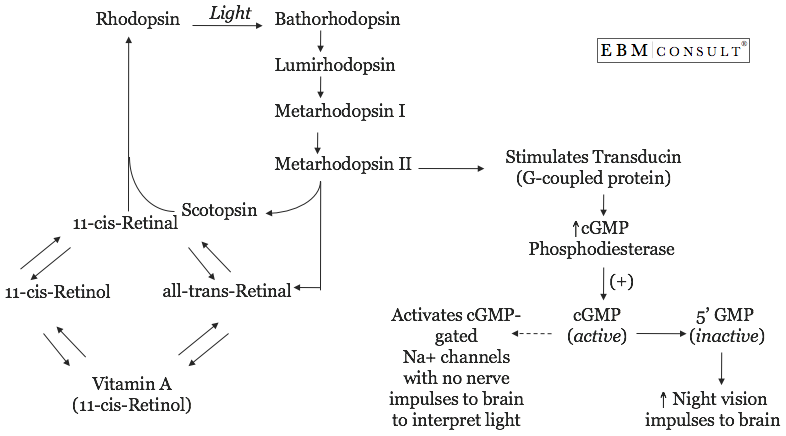Which Vitamin Helps With Day And Night Vision In Animals?
-
Vitamin A (likewise chosen all-trans-retinol or all-trans-retinoic acid) is a well-known fat soluble vitamin establish in many foods and dietary supplements. Vitamin A has been shown to be useful in helping with nighttime vision, merely not daytime vision.
Our ability to see is dependent on two master photoreceptors that sit down in the posterior aspect of the eye, the rods and cones (with the rods outnumbering the cones by a ratio of xx:ane).1 To be able to meet, low-cal must kickoff enter into and laissez passer through the lens of the centre and and so travel through the posterior segment (vitreous sleeping room). Next, light must travel through ten layers of the neural retina to get to the rods and cones.one The rods and cones are made up of an inner segment that contains the nucleus and an outer segment that is fabricated upwards of discs that contain light-absorbing photopigments.1 When comparison the two photoreceptors, the rods are useful for night vision and the cones are useful for day vision. Vitamin A is one of the required precursors for the formation of rhodopsin, the photopigment found in rods. Rhodopsin helps us to see at night and without vitamin A, rhodopsin cannot course and "dark incomprehension" occurs.2
ol
Why is vitamin A needed for night vision to occur?
Vitamin A (all-trans-retin) is a precursor to the formation of the photopigment rhodopsin, which is located in the rods. In lodge for rhodopsin to be formed, vitamin A must be converted to 11-cis-retin
al. This can occur in ane of two ways. Vitamin A (all-trans-retin
ol) can be converted to 11-cis-retin
olby isomerase. This 11-cis-retin
oltin then be converted to 11-cis-retin
al. Alternatively, vitamin A (all-trans-retin
ol) can be converted to all-trans-retin
alwhich tin then exist converted to 11-cis-retin
al. At present that 11-cis-retinal has been formed by either method, it tin can combine with scotopsin to class the rhodopsin. As rhodopsin absorbs light in the rods, a conformational alter occurs in 11-cis-retinal to go all-trans-retinal. A conformational alter also occurs in the opsin fragment to form metarhodopsin II, which is the activated form of rhodopsin. The metarhodopsin II then stimulates transducin, a Thou-coupled poly peptide found on the surface of the disk within the outer membrane in the rod jail cell. This activation of transducin causes an activation in cGMP phosphodiesterase, which volition remove the cGMP mediated activation of cGMP-gated channels that are letting Na+ ions leak into the rod cytoplasm resulting in a hyperpolarization of that rod cell. Thus, in the presence of calorie-free, the blockage of Na+ motion into the rod cell will event in a hyperpolarization of that rod cell which then allows letters about lite being seen during night vision to be sent to the brain for concluding interpretation.

In addition to vitamin A'southward office in helping the rods in our eyes convert calorie-free into neuronal impulses for our brain, it is too required to maintain normal differentiation of the cornea and conjunctival membranes which helps prevent other aberrant heart atmospheric condition, such as xerophthalmia. The Nutrient and Nutrition Board, Found of Medicine - National Academy of Sciences advises that the Recommended Daily Allowances (RDA; given beneath as retinol activity equivalents (RAE'southward)) and Tolerable Upper Intake Level (ULs) be the post-obit:
- Children 1 to 3 years of age: RDA = 300 mg/d with UL = 600mg/d.
- Children 4 to viii years of age: RDA = 400 mg/d with UL = 900mg/d.
- Males & Females 9 to thirteen years of age: RDA = 600 mg/d with UL = ane,700mg/d.
- xiv to eighteen years of age: RDA = 700mg/d for females and 900mg/d for males with UL = two,800mg/d.
- > 18 years of age: RDA = 700mg/d for females and 900mg/d for males with UL = 3,000mg/d.
If the supplement is measured in International Units (IU), there is no known direct equivalent from RAE to IU, but it tin be estimated how many RAEs there are in that supplement. Commencement cheque the label on the supplement and determine the source of vitamin A (either retinol or beta-carotene). If information technology is retinol, multiply the IU by 0.three to become the micrograms of RAE or multiply the number of micrograms of RAE by 3.3 to become the number of IU. If it is beta-carotene, multiply the number of IUs by 0.025 to become the number of micrograms of RAE or multiply the number of RAE past 39.6 to get the number of IUs.
Every bit with any medication or supplement, excessive doses or unnecessary exposure tin exist harmful. Therefore, doses above the UL should be avoided because Vitamin A has been associated with an increase risk for hip fracture in postmenopausal women, lung cancer, cardiovascular mortality and total bloodshed.3-half-dozen.
References:
- Wässle H, Boycott BB. Functional architecture of the mammalian retina. Physiol Rev 1991;71(2):447-eighty.
- Wald G. Molecular ground of visual excitation. Science 1968;162(850):230-9.
- Feskanich D, Singh V, Willett WC et al. Vitamin A intake and hip fractures amid postmenopausal women. JAMA 2002;287(1):47-54.
- No Authors. The effect of vitamin Eastward and beta carotene on the incidence of lung cancer and other cancers in male smokers. The Alpha-Tocopherol, Beta Carotene Cancer Prevention Study Group. N Engl J Med 1994;330(xv):1029-35.
- Omenn GS, Goodman GE, Thornquist MD et al. Furnishings of a combination of beta carotene and vitamin A on lung cancer and cardiovascular affliction.N Engl J Med 1996;334(18):1150-five.
- Omenn GS, Goodman GE, Thronquist MD et al. Risk factors for lung cancer and for itnervention effects in CARET, the Beta-Carotene and Retinol Efficacy Trial. J Natl Cancer Inst 1996;88(21):1550-nine.
Source: https://www.ebmconsult.com/articles/vitamin-a-eye-vision-mechanism
Posted by: ferraraemparch.blogspot.com

0 Response to "Which Vitamin Helps With Day And Night Vision In Animals?"
Post a Comment